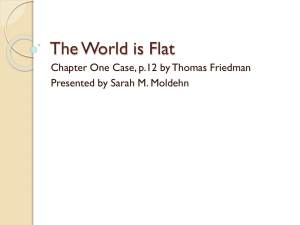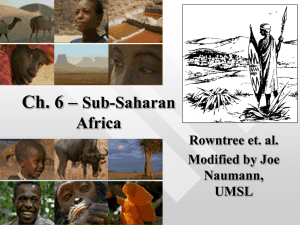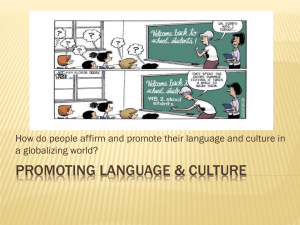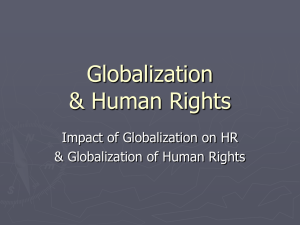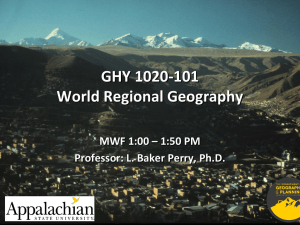Chapter 4: Latin America
advertisement
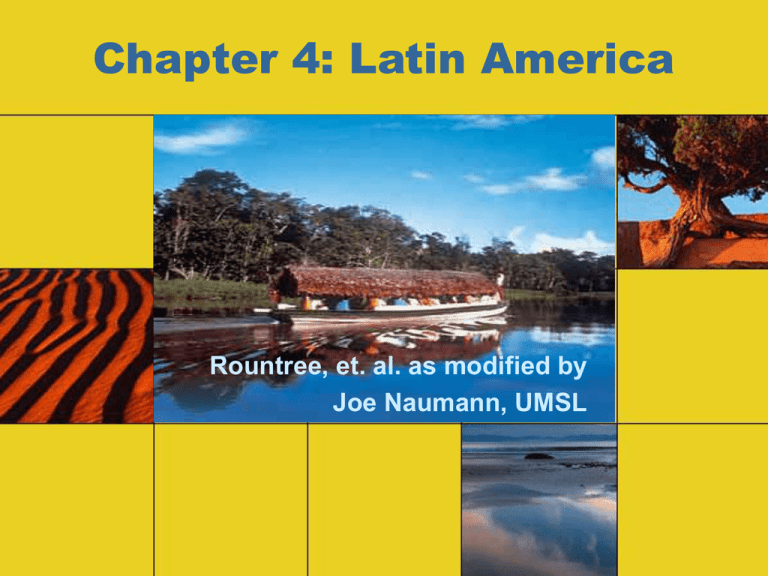
Chapter 4: Latin America Rountree, et. al. as modified by Joe Naumann, UMSL Ch. 4 Latin America (fig. 4.1) Globalization & Diversity: Rowntree, Lewis, Price, Wyckoff 2 Learning Objectives • First chance to integrate foundation concepts with a relatively unfamiliar region, and compare regions • Understand Latin America’s culture, and how colonization has affected it • Know about the Andes and the Amazon • Understand these concepts and models: -Agrarian Reform -Altiplano -Dependency Theory -El Nino -Dollarization -Maquiladora -Growth poles -Mercosur Globalization & Diversity: Rowntree, Lewis, Price, Wyckoff 3 Introduction • Latin America has 17 countries – Colonized by Spain & Portugal (Iberian countries) – Large, diverse populations • 490 million people total • Indian and African presence • 75% of the people live in cities • Several megacities (more than 10 million people) – Industrialization & development grew since 1960s • Free Trade Area of the Americas (FTAA) proposes to integrate economies of Latin America, North America and the Caribbean (except Cuba) • Natural resource extraction remains important Globalization & Diversity: Rowntree, Lewis, Price, Wyckoff 4 Common Treatment of the Area • Middle America – From Mexico south through Panama • The Caribbean coastal area has much in common with the islands, culturally and economically – The islands of the Caribbean • South America – The remainder of what Rowntree refers to as Latin America. • Latin America, for many authors, encompasses both Middle America and South America Globalization & Diversity: Rowntree, Lewis, Price, Wyckoff 5 South American Location • Mostly east of North America • Does not extend as far south toward the pole as North America extends north toward the pole. Has climatic implications CONTINENTALITY NO Globalization & Diversity: Rowntree, Lewis, CONTINENTALITY Price, Wyckoff 6 Neotropical Diversity • Much of the region lies in the tropics, but not all – Neotropics: tropical ecosystems of the Western Hemisphere • Large species diversity, inspired Darwin • Environmental Issues Facing Latin America • Relatively large land area and low population density has minimized environmental degradation • Latin America has the opportunity to avoid mistakes that other regions have made • Brazil and Costa Rica have conservation movements – The Destruction of Tropical Rainforests • Deforestation is the most common environmental problem in Latin America Globalization & Diversity: Rowntree, Lewis, Price, Wyckoff 7 Rainforests may help create the humidity needed for tropical precipitation. • Major oxygen producer – can we risk losing it? Globalization & Diversity: Rowntree, Lewis, Price, Wyckoff 8 Environmental Geography • Destruction of Tropical Rainforests ( – Affected regions: Atlantic coastal forests of Brazil and Pacific forests of Central America – Causes: agriculture, settlement, and ranching • Grassification: conversion of tropical forest to pasture – Concerns: loss of biological diversity • Tropical rainforests: 6% of Earth’s landmass but 50% of species • Urban Environmental Challenges: Valley of Mexico -Air pollution, smog -Water resources: quality & quantity -Sinking land: occurring as Mexico City draws down aquifer -Modern urban challenges: squatter settlements But Curitaba is a “Green City” Globalization & Diversity: Rowntree, Lewis, Price, Wyckoff 9 Environmental Issues in Latin America (Fig. 4.3) Globalization & Diversity: Rowntree, Lewis, Price, Wyckoff 10 Western Mountains & Eastern Shields • The Andes – Relatively young, 5,000 miles long; 30 peaks over 20K feet – Contain valuable metals and minerals – Altiplano: treeless, elevated plain in Peru and Bolivia • The Uplands of Mexico and Central America – Most major cities and population found here – Rich volcanic soils • The Shields – Large upland plateaus of exposed crystalline rock • Brazilian shield is the largest, covering most of Brazil • Has natural resources and settlement Globalization & Diversity: Rowntree, Lewis, Price, Wyckoff 11 Physical Geography of Latin America (Fig. 4.7) Globalization & Diversity: Rowntree, Lewis, Price, Wyckoff 12 Some Key Physical Areas Sierra Madre Oriental & Occidental Greater Antilles Lesser Antilles Llanos Central Plateau of Mexico Andes Mountains Altiplano Amazon Guiana Highlands Brazilian Highlands Mato Grosso Patagonia Globalization & Diversity: Rowntree, Lewis, Price, Wyckoff Pampa 13 Middle America: Hazardous • One of the most hazardous areas in the world to live. – West Coast subduction zone • Active volcanoes • Earthquake prone • Tsunamis – coastal flooding – Caribbean Hurricane Prone • Wind damage • Flooding damage Globalization & Diversity: Rowntree, Lewis, Price, Wyckoff 14 WORLD HURRICANE TRACKS Globalization & Diversity: Rowntree, Lewis, Price, Wyckoff 15 DISTRIBUTION OF EARTHQUAKES & VOLCANOES Globalization & Diversity: Rowntree, Lewis, Price, Wyckoff 16 Click on the sign to see the video Globalization & Diversity: Rowntree, Lewis, Price, Wyckoff 17 Environmental Geography • River Basins and Lowlands – Amazon Basin • Largest river system in world by volume; second in length • Draws from nine countries – Plata Basin • Region’s second largest river watershed; economically productive • Climate • Little temperature variation in many areas • Larger regional variations in precipitation – El Nino • Warm Pacific current that usually arrives along coastal Ecuador and Peru in December – Regional weather upsets (drought, torrential rain, flooding) Globalization & Diversity: Rowntree, Lewis, Price, Wyckoff 18 PRECIPITATION Major Influences: Southeast Trade Winds, the Andes Mountains, & the Peru Current Globalization & Diversity: Rowntree, Lewis, Price, Wyckoff 19 Climate Map of Latin America (Fig. 4.11) Globalization & Diversity: Rowntree, Lewis, Price, Wyckoff 20 Altitudinal Zonation & Climate Windward side will be wet and leeward side will be dry Leeward Windward Globalization & Diversity: Rowntree, Lewis, Price, Wyckoff 21 ALTITUDINAL ZONATION • Vertical Climate Zones and Agriculture Globalization & Diversity: Rowntree, Lewis, Price, Wyckoff 22 Altitudinal Zonation in Action TIERRA FRIA Tierra TIERRA HELADA (ColdNevada Land) TierraTEMPLADA Helada TIERRA (Frost Land) Corn, Wheat, Potato TIERRA CALIENTE (Temperate Land) 3,600 m 12,000’ Coffee,(Hot Rice,Land) Corn, Sugar 6,000’ 2000’ Sea Level Bananas,Tierra Cocoa, FriaSugar, Rice 2,000 m Tierra Templada 600 m Tierra Caliente Globalization & Diversity: Rowntree, Lewis, Price, Wyckoff Sea 23 Level Snow at the Equator – temperature drops 3.5ºF per 1000 ft. elevation Globalization & Diversity: Rowntree, Lewis, Price, Wyckoff 24 Dominance of Cities • The Pattern – Interior lowlands of South America sparsely populated • Brazilia: an attempt to draw more development to the interior of Brazil – a growth pole – Higher population in Central America and Mexico interior plateaus – Dramatic population growth in 1960s and ’70s • The Latin American City – Urbanization began in 1950s; today 75% urbanized – Urban primacy: a country has a primate city 3 to 4 times larger than any other city in the country – Urban form – Reflects colonial origins and contemporary growth – Latin American City Model • Squatter settlements: makeshift housing on land not legally owned or rented by urban migrants, usually in unoccupied open spaces in 25 or near a rapidly growing city Globalization & Diversity: Rowntree, Lewis, Price, Wyckoff Population Map of Latin America (Fig. 4.12) Globalization & Diversity: Rowntree, Lewis, Price, Wyckoff 26 Latin American City Model (Fig. 4.13) Periferico: circumferential, outer highway Disamenity: a zone of established slums much like the peripheral squatter settlements In Situ Accretion: a transition zone from the inner Globalization & Diversity: 27 ring of affluence to the outerRowntree, ringLewis, of poverty – modest Price, Wyckoff housing interspersed with unkempt areas. Population and Settlement (cont.) • The Latin American City (cont.) – Rural-to-Urban Migration • Since the 1950s, peasants began to migrate to urban areas – Mechanization of agriculture, population pressure, consolidation of lands • Patterns of Rural Settlement • 130 million people (25%) live in rural areas – Rural Landholdings • Large estates used the best lands, relied on mixture of hired, tributary, and slave labor • Latifundia: Long-observed pattern of maintaining large estates – Feudal system transferred from Spain to the “New World” Globalization & Diversity: Rowntree, Lewis, • Minifundia: pattern associated with peasants Price, Wyckoff farming small plots for their own subsistence 28 Pop. & Settlement • Patterns of Rural Settlement (cont.) – Agricultural Frontiers • Brazilian Amazon settlement is controversial – Short-term benefits – Long-term disaster • Provided peasants with land (???), tapped unused resources, shored up political boundaries • Population Growth and Movements • Rapid growth throughout most of the century followed by slower growth – Family planning: counter-cultural & counter-religious – Declining Total Fertility Rates (TFRs) since 1980s – European Migration • Migration encouraged to till soils and “whiten” the mestizo population (of mixed European and Indian ancestry) – Many Europeans immigrated between 1870s and 1930s Globalization & Diversity: Rowntree, Lewis, Price, Wyckoff 29 Pop. & Settlement • Population Growth and Movements (cont.) – Asian Migration • Many Chinese and Japanese between 1870s and 1930s – Former president of Peru a Japanese descendent • New wave of immigrants from South Korea – Latino Migration and Hemispheric Change • Economic opportunities spurred migrations within Latin America, or from Mexico to the U.S. • Political turmoil, civil wars caused migration Globalization & Diversity: Rowntree, Lewis, Price, Wyckoff 30 Effects of Central America’s Mountains Country Population Physiologic density Guatemala 12.3 million 696.6 per sq. mi. Honduras 6.2 million 539.1 El Salvador 6.1 million 1155.2 Nicaragua 4.8 million 157.2 Costa Rica 3.5 million 316.8 Panama 2.8 million 331.1 Belize 240,000 451.2 Globalization & Diversity: Rowntree, Lewis, Price, Wyckoff 31 Principal Latin American Migration Flows (Fig. 4.14) Globalization & Diversity: Rowntree, Lewis, Price, Wyckoff 32 Repopulating a Continent • The Decline of Native Populations – There were many complex civilizations in Latin American before Europeans arrived • 1500: population of 47 million; 1650: 5 million • Causes: – disease, – warfare, – forced labor, – collapse of food production system Globalization & Diversity: Rowntree, Lewis, Price, Wyckoff 33 Out of the Loop • Indian Survival – Largest populations of Indians today: Mexico, Guatemala, Ecuador, Peru, and Bolivia – Indians trying to secure recognized territory in their countries • Comarca: loosely defined territory similar to a province or homeland, where Indians have political and resource control Globalization & Diversity: Rowntree, Lewis, Price, Wyckoff 34 INDIAN CULTURE HEARTHS • SOURCE AREAS from which radiated ideas, innovations, and ideologies that changed the world beyond. MA Hearths Aztecs Mayans Globalization & Diversity: Rowntree, Lewis, Price, Wyckoff 35 Inca Culture Hearth Globalization & Diversity: Rowntree, Lewis, Price, Wyckoff 36 Machu Pichu – terraced mountain top Inca city Globalization & Diversity: Rowntree, Lewis, Price, Wyckoff 37 Terraces at Machu Pichu Globalization & Diversity: Rowntree, Lewis, Price, Wyckoff 38 Achievements: • Bridge building and mountain roads • Irrigation • Surgery through the skull • Highly organized social/economic structure • Effective management of conquered peoples Globalization & Diversity: Rowntree, Lewis, Price, Wyckoff 39 Cultural Patterns • Patterns of Ethnicity and Culture • Racial caste system – Spanish legacy: blanco (European), mestizo (mixed ancestry), indio (Indian), negro (African) • Colonial structure – transplanted feudalism – Peninsulares – – Creoles – – Mestizo – – European/African mix – Native Americans (Indians) & Africans • Independence equality of Peninsulares & Creoles • Blancos dominated social, political, & economic systems for more than a century Globalization & Diversity: Rowntree, Lewis, Price, Wyckoff 40 Patterns of Culture – Languages • About 2/3 Spanish, 1/3 Portuguese speakers • Indigenous languages in central Andes, Mexico, Guatemala – Blended Religions • 90% Roman Catholic (nominally) – El Salvador, Uruguay have sizeable Protestant populations • Syncretic religions: – Voodoo – Catholicism and African religions, with Brazil’s carnival as an example Globalization & Diversity: Rowntree, Lewis, Price, Wyckoff 41 Catholic Influence • Traditionally provided education & health care • Established many of the social mores • Higher clergy often came from the aristocracy and supported the status quo • Social role of the Church has grown in some places becoming an advocate for the poor and disenfranchised – Bishop Romero in Nicaragua (assassinated) • Has opposed most birth control methods in countries with high birth rates and great poverty • Many may be Catholic “in name only” Globalization & Diversity: Rowntree, Lewis, Price, Wyckoff 42 Machismo • Male oriented society – definitely a double standard • Traditionally, marriages were arranged – a greater disadvantage for women – upper class men were expected to be unfaithful • Admiration for the strong, forceful male – Dictators were often admired as much as they were feared – Military often a vehicle for advancement and control – Compromise seen as a sign of weakness • Male resistance to birth control -- # of male children often considered a measure of one’s manhood Globalization & Diversity: Rowntree, Lewis, Price, Wyckoff 43 Language Map of Latin America (Fig. 4.19) Globalization & Diversity: Rowntree, Lewis, Price, Wyckoff 44 Colombian Exchange • Amerindians Contributed: – Corn (maize), sweet potato, several kinds of beans, the tomato, several kinds of squash, cacao, & tobacco (Potato – from Peru) – Gonorrhea & rheumatoid arthritis • Europeans Contributed: – Wheat, oats, rye, & other European crops, horse, cow, sheep, pigs, chicken – Syphilis, small pox, chicken pox, measles, mumps, typhoid fever, influenza, etc. – African slaves also brought tropical diseases for which Amerindians had no immunity or resistance Globalization & Diversity: Rowntree, Lewis, Price, Wyckoff 45 European Settlement • Initially drawn to areas of Incan rule and wealth (Spanish) – “God, Glory, & Gold” – At first kept the Inca as a puppet ruler – Quickly turned to serfdom • Hacienda was the New World “Manor” – Land seen as the symbol of and source of wealth – Land Alienation transfer of Amerindian lands to European ownership – Amerindians became the “serfs” Globalization & Diversity: Rowntree, Lewis, Price, Wyckoff 46 Redrawing the Map – Cycles of antagonism and cooperation • Organization of American States (OAS) • MERCOSUR (Southern Cone Common Market) • Iberian Conquest and Territorial Division • Treaty of Tordesillas divided South America between Spain and Portugal – Revolution and Independence • Creoles led revolutions, resulting in the creation of new countries – Persistent Border Conflicts • Colonial boundary lines were not well accepted • When states gained independence, border issues grew Globalization & Diversity: Rowntree, Lewis, Price, Wyckoff 47 Shifting Political Boundaries Globalization & Diversity: Rowntree, Lewis, Price, Wyckoff (Fig. 4.21) 48 Geopolitical Framework • Iberian Conquest and Territorial Division – The Trend Toward Democracy • Long independence, but political stability has been a problem • Democratic elections since 1980s • Most of the countries are free-market democracies • Regional Organizations • Supranatural organizations: governing bodies that include several states • Subnational organizations: groups that represent areas of people within the state Globalization & Diversity: Rowntree, Lewis, Price, Wyckoff 49 Regional Organizations – Trade Blocks • To foster internal markets and reduce trade barriers – Latin American Free Trade Association (LAFTA), Central American Common Market (CACM), Andean Group, NAFTA, Mercosur – Insurgencies and Drug Traffickers • Guerrilla groups have controlled large portions of their countries through violence and intimidation – FARC (Revolutionary Armed Forces of Colombia); ELN (National Liberation Army) – Colombia has highest murder rate in the world • Drug cartels: powerful and wealthy organized crime syndicates Globalization & Diversity: Rowntree, Lewis, 50 Price, Wyckoff Rebel-held areas of Colombia Notice the relationship between coca growing areas and insurgency. The drugs supply the money to support the movement. Globalization & Diversity: Rowntree, Lewis, Price, Wyckoff 51 Long-standing Conditions • • • • Poverty – widening gap between rich & poor Military governments & dictators until recently Rule by the “aristocracy” Rather rigid social structure – Amerindians usually left out of the “loop.” • In agriculture, trapped in an international economic order they cannot change – One crop economies – Products which aren’t necessities – A cartel like OPEC won’t work Globalization & Diversity: Rowntree, Lewis, Price, Wyckoff 52 Important Recent Developments • Mexico’s “one-party democracy” seems to have ended – Presidente Fox of PAN • Democratically elected governments in all countries except Cuba – – even in Cuba communism is changing due to the loss of Soviet/Russian financial assistance – When Castro retires (or probably when he dies) there may be greater change – i.e., the Pope’s visit would have been unheard of 20 years ago – One can even see the possibility of the resumption of U.S. diplomatic relations on the horizon Globalization & Diversity: Rowntree, Lewis, Price, Wyckoff 53 A Glimpse of Mexico • Click on the map to see the video Globalization & Diversity: Rowntree, Lewis, Price, Wyckoff 54 Dependent Economic Growth • Most Latin American countries are “middle income” – Extreme poverty in the region, however • Development Strategies • Import substitution: policies that foster domestic industry by imposing inflated tariffs on all imported goods – Industrialization • Manufacturing emphasized since 1960s – Growth poles: planned industrial centers – Maquiladoras and Foreign Investment • Maquiladoras: Mexican assembly plants lining U.S. border • Other Latin American countries attracting foreign companies – The Informal Sector • Provision of goods & services without government regulation • Self-employment: construction, manufacturing, vending, etc. Globalization & Diversity: Rowntree, Lewis, Price, Wyckoff 55 MAQUILADORAS Tijuana Nogales Ciudad Juarez Chihuahua Monterrey Reynosa Matamoros Globalization & Diversity: Rowntree, Lewis, Price, Wyckoff 56 MAQUILADORAS • Initiated in the 1960s • Assembly plants in Mexico that pioneered the migration of industries in the 1970s • Today –>4,000 maquiladoras –>1 million employees Globalization & Diversity: Rowntree, Lewis, Price, Wyckoff 57 MAQUILADORAS • Modern industrial plants • Assemble imported, duty-free components/raw materials • Export the finished products • Mostly foreign-owned (U.S., Japan) • 80% of goods reexported to U.S. • Tariffs limited to value added during assembly Globalization & Diversity: Rowntree, Lewis, Price, Wyckoff 58 MAQUILADORAS • Maquiladora products • • • • • Electronic equipment Electric appliances Auto parts Clothing Furniture Globalization & Diversity: Rowntree, Lewis, Price, Wyckoff 59 MAQUILADORAS • ADVANTAGES – Mexico gains jobs & Mexican workers have more money to spend on both Mexican and U.S.-made products. – Foreign owners benefit from cheaper labor costs. EFFECTS – Regional development – Development of an international growth corridor between Monterrey and Dallas - Fort Worth Globalization & Diversity: Rowntree, Lewis, Price, Wyckoff 60 NAFTA • Effective 1 January 1994 • Established a trade agreement between Mexico, Canada and the US, which: –Reduced and regulated trade tariffs, barriers, and quotas between members –Standardized finance & service exchanges –May expand membership Globalization & Diversity: Rowntree, Lewis, Price, Wyckoff 61 NAFTA How has Mexico benefited from NAFTA? Will Chile join it? Globalization & Diversity: Rowntree, Lewis, Price, Wyckoff 62 MEXICO AND NAFTA • Foremost, it promises a higher standard of living – more people with higher incomes may also buy more U.S. products. • NAFTA creates more jobs for Mexicans as US companies begin to invest more heavily in the Mexican market. • Mexican exporters increase their sales to the US and Canada. • Is that the entire story? Globalization & Diversity: Rowntree, Lewis, Price, Wyckoff 63 WAGE RATES COMPARED $20.21 $25 $20 $17.38 $15 Mexico U.S. $10 $1.55 $2.87 $5 $0 Assemblers Skilled Labor History shows that over time, wages will increase in Mexico, closing the gap somewhatGlobalization & Diversity: Rowntree, Lewis, Price, Wyckoff 64 Economic and Social Development (cont.) • Primary Exports • Latin America specialized in commodities into the 1950s – Bananas, coffee, cacao, grains, tin, rubber, petroleum, etc. – Agricultural Production • Since 1960s, agriculture has become more diversified and mechanized • Machinery, hybrid crops, chemical fertilizers, pesticides, make agriculture very productive – Mining and Forestry • • • • Products: silver, zinc, copper, iron ore, bauxite, gold, oil, gas Mexico, Venezuela, Ecuador export oil Mining becoming mechanized, laying off workers Logging – Exportation of wood pulp provide short-term cash infusion – Plantation forests of introduced species replace diverse native forests Globalization & Diversity: Rowntree, Lewis, 65 Price, Wyckoff Economic and Social Development (cont.) • Latin America in the Global Economy • Dependency theory – Dependency theory holds that expansion of European capitalism created Latin American condition of underdevelopment » Creates prosperous cores and dependent, poor peripheries – Increased economic integration within Latin America and dominance of U.S. market – Neoliberalism as Globalization • Neoliberal policies: stress privatization, export production, and few restrictions on imports – Benefits include increased trade and more favorable terms for debt repayment; most political leaders are embracing it » Some signs of discontent with neoliberalism and support for reduction of poverty and inequality Globalization & Diversity: Rowntree, Lewis, Price, Wyckoff 66 Latin America in the Global Economy – Dollarization • Dollarization: process in which a country adopts (in whole or in part) the U.S. dollar as its official currency – Full dollarization – U.S. dollar becomes only currency » Until 2000, Panama was the only fully dollarized Latin American country » Ecuador also became fully dollarized in 2000 » El Salvador considering – Limited dollarization more common strategy » U.S. dollars circulate with country’s national currency • Tends to reduce inflation, eliminate fears of currency devaluation, and reduce costs of trade Globalization & Diversity: Rowntree, Lewis, 67 Price, Wyckoff Developing countries seek a bigger and better “piece of the pie” • Banana plantations are declining in importance in Costa Rica, whereas there are growing numbers of workers in high-tech fields and tertiary and quaternary activities. Globalization & Diversity: Rowntree, Lewis, Price, Wyckoff 68 Social Development • Marked improvements since 1960 – Declining child mortality rate, along with higher rates for life expectancy and educational attainment » Most countries had child mortality cuts of 50% or more » Important role for non-govt. organizations (NGOs) » Humanitarian organizations, churches, community activists – Still, regional social differences within countries – Race and Inequality • Relative tolerance, but Amerindians and blacks overrepresented among the poor – Hard to ignore ethnicity and race when explaining contrasts in income and availability of services Globalization & Diversity: Rowntree, Lewis, Price, Wyckoff 69 Mapping Poverty and Prosperity (Fig. 4.29) Globalization & Diversity: Rowntree, Lewis, Price, Wyckoff 70 Status of Women • Many women work outside the home (30%-40%) –Lower than rate in U.S. but comparable to many European countries • Legally, women can vote, own property, and sign for loans, but less likely than men to do so – Reflective of patriarchal tendencies • Low illiteracy rates –Highest rates in Central America • Trend toward smaller families –Related to education and workforce participation Globalization & Diversity: Rowntree, Lewis, Price, Wyckoff 71 Monroe Doctrine & U.S. Intervention • • • • • • Panama – aided it’s revolt for independence Guatemala Nicaragua– helped create Somoza dictatorship Haiti Dominican Republic Mexico (took ½ Mexico’s territory) – 1912 invasion to capture Pancho Villa (failed) • Spanish American War – took Puerto Rico & kept right to intervene in Cuba until 1935 Globalization & Diversity: Rowntree, Lewis, Price, Wyckoff 72 U.S. Intervention Since 1960 • Cuba – Bay of Pigs, Cuban missile crisis, economic embargo – relations now improving • Troops to Dominican Republic (????) • Illegal Iran-Contra involvement in Nicaraguan civil war • Troops to Grenada • Invasion of Panama to capture its president Noriega – brought to U.S. tried for drug charges and imprisoned in U.S. • Intervention in Haiti to restore president Globalization & Diversity: Rowntree, Lewis, Price, Wyckoff 73 Perceptions Differ • The U.S. likes to be perceived as a friendly neighbor & upholder of principles of human dignity. – Not easily accomplished when one is a big power seeking its best interests • Middle & South American perspective – “Gringo” isn’t a complimentary term – U.S. often called “the colossus of the north.” – U.S. often supported dictators if they were avowedly “anti-communist.” – disastrous in Cuba & Nicaragua – U.S as an economically imperialistic country Globalization & Diversity: Rowntree, Lewis, Price, Wyckoff 74 Conclusion •Latin America is the first region fully colonized by Europe •Demographic recovery slow after early population decline •Latin America is rich in natural resources •But will resources be exploited for short-term gain or sustainability? •Active informal economy, rapid development End of Chapter 4: Latin America Globalization & Diversity: Rowntree, Lewis, Price, Wyckoff 75
